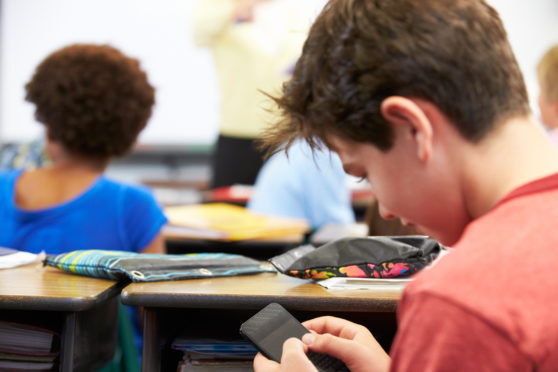If there was one simple thing which could be done in schools to improve young people’s social skills, reduce bullying and mental health problems and, above all, to improve exam performance you would expect schools to embrace it, right?
If I told you this simple thing was not only free, but that it would take up virtually no teaching time or resources, would you be astonished if there was any reluctance?
Yet a furious debate has emerged over whether or not mobile phones should be banned in schools.
It began with comments by the founder of Michaela Community School in London. The press have dubbed this school the ‘strictest in Britain’ but a no-nonsense approach by the headteacher Katharine Birbalsingh has led to outstanding exam results in an area of high deprivation. Ms Birbalsingh says that mobile phones are ‘dangerous’ and the equivalent of letting pupils smoke, drink and look at porn in school.
This was contradicted by Jane Prescott, the new chair of the Girls School Association who said that mobile phones are being ‘demonised’ and that they should be allowed in schools and classrooms in order to make sure young people are familiar with technology and learn how to use it wisely. Meanwhile Kilgraston independent school in Bridge of Earn recorded its best exam results in five years after banning mobile phones. Research suggests this phenomenon is not limited to this school – it is a common result in schools where phones are highly restricted.
My own employer, Gordonstoun, implemented a mobile phone ban two years ago and instantly saw in increase in noise levels as children socialised face to face and developed all-important social skills.
There is no guidance for teachers on this matter and no formal policy either.
I have my own reasons for wanting this addressed urgently. Not only do children mature at different rates but some children have special reasons why they can’t have access to a phone. My eldest adopted son, who attends state school, has a host of mental health problems which we are still trying to get properly diagnosed. But what has become clear is that he does not have the maturity or self-control to have a mobile phone. Each time we give it a try he uses it inappropriately – he sends unpleasant texts, searches adult subjects online and has even shared illegal images.
For a child who cannot foresee consequences, is desperate to impress his peers and is prone to erratic behaviour, a phone opens a world of danger which could easily end in a criminal record. We have had to remove it from him forever, yet this means that every day he is the only child on the bus not playing online games on his phone and he is the only child at break-times who is not able to laugh at a Snapchat filter or respond to group-chats. In lessons, his isolation continues as he is the only one who cannot take photos for a project. He can’t even access his homework tasks, which are set on a homework app. (The app is great for parents to monitor progress but only the child can access homework tasks.).
Due to the neglect he suffered in his early life, he is more desperate than most to fit in and develop firm friendships yet he may as well have a huge red arrow pointing over his head which says, ‘This child is strange and different! He has NO PHONE!!’
When I had the embarrassing task of ringing a parent to apologise for his latest inappropriate text, the child’s mum – once she had recovered from understandable anger – shared my frustration at the huge pressure on parents to allow their children a phone at school simply to fit in.
We try so hard to make sure children with a wide range of learning difficulties can access mainstream education. We have school uniforms so that children do not feel different but what’s the point when we allow children to carry an incredibly expensive device? We focus on raising attainment but allow an object which research shows lowers exam performance. Most of all, are many children in care who cannot have access to a phone because it places them in danger. Whether the children are poor, underachieving or at risk of harm, we are instantly identifying the ‘cool’ kids from the ‘uncool’.
Of course there can be good reasons for allowing phone use. One of the amazing features of this technology is that it can be adapted for all kinds of disabilities at the touch of a screen. There can always be exceptions for the right reasons. However there is a big difference between adapting a policy to help an individual child and having no policy at all.
If all pupils were required to put phones away during the school day, imagine what might happen. Bullies would find it harder to hide their behaviour. The school clubs would fill up. Our overweight children might get fitter. Young people would build meaningful friendships. They would learn how to talk to people they haven’t met before without the option of a phone screen to stare at. There would be less time to look at unachievable images of beauty and more time to realise that everyone has their own attractive qualities. A reduction in the number of selfies would certainly reduce an obsession with our own image.
Best of all, the children who don’t have a phone because their parents and carers can’t afford it, don’t want it or can’t allow it, will not be a social pariah.
Eleanor Bradford is a former BBC Scotland Health Correspondent and now works in communications in the education sector











